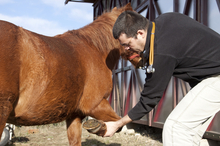The inactivity that goes with horses being kept in stalls during winter months sometimes leads to a condition known as "stocking up." The horse owner notices that a horse's leg or legs have become swollen and filled with fluid over night. In some cases the leg feels perfectly normal except for the swollen condition. In other cases, the leg feels warm and the horse flinches when the leg is touched.

Veterinarian examining horse's leg
Simple stocking up will usually resolve after 30 minutes or so of light exercise for the horse, but if heat and pain are present, the condition may be more serious.
Horses can rapidly develop swelling or “filling” in one or more legs. Sometimes it is extremely serious. Other times, the swelling can be related to inactivity, especially if it is an older horse.
Dr. Linda Gray, writing for SmartPak addresses the issues related to leg swelling in horses known as "stocking up."
Stocking up is harmless swelling in the lower legs due to decreased circulation. Reduced activity is what usually leads to this pooling of blood and other fluids in the extremities. The swelling can be found from the coronary band to the ankle or all the way up the cannon bone to the knee or hock and can occur in all four legs or just one pair.
Often seen when an active horse is kept in a stall for several days, Stocking up is more common in older horses as well as horses with large bodies and small feet. Unfortunately, a horse that is prone to stocking up usually continues to have this problem throughout its life.
Simple stocking up will usually resolve after 30 minutes or so of light exercise, such as hand walking, lunging or easy riding. Cold-hosing or applying a poultice are other techniques which increase circulation and get fluids moving.
Standing bandages can be used to prevent fluid from pooling in the lower limbs but the horse should be allowed some time with no support wraps. Twelve hours on and twelve hours off is a common schedule. The best prevention, though, is more turnout and less stall time.
Swelling in a single leg is likely to signal a serious condition. Horses can “blow up” a leg in response to a scratch, cut, or puncture wound that may be so insignificant that it’s hard to find. The leg may be warm in addition to being swollen. This swelling isn’t likely to go down until the wound is cared for and any infection is treated.
Serious medical conditions that can cause the legs to swell are usually accompanied by heat, pain and lameness or changes in appetite or attitude such as lethargy or depression.
If your horse has leg swelling accompanied by lameness, warmth in the leg or hoof, or an elevated body temperature, it’s time to call the veterinarian. This is more than simple stocking up.
A horse that has significant swelling in all four legs may have some type of systemic illness. This could be a sign of heart trouble, liver or kidney disease, or a bacterial or viral infection. It’s defintely a situation that calls for a veterinary examination.
